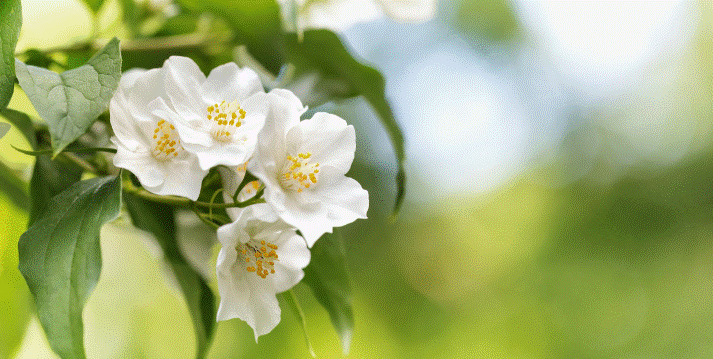Mock Orange

FASHION is as much a fact in gardening as it is in a dress. Plants are in and out of fashion for a bewildering number of reasons or sometimes for no reason at all.
Dwarf conifers were all the rage just a few years ago. Lately, ornamental grasses have enjoyed similar popularity.
Herbaceous borders, the mainstay of gardens 80 years ago, are coming back.
But one group of plants that fell from fashion over 40 years ago still shows little signs of revival.
These are the flowering deciduous shrubs such as deutzias, spiraeas, quinces, and mock oranges.
Where once scores of cultivars were generally available, now only a few can be purchased.
For some shrubs, the reasons for loss of favor are apparent: poor growth habits, too modest a bloom, or susceptibility to diseases.
But I think mock oranges should never have been neglected. Their decline seems due chiefly to a fickleness of taste and a lack of understanding of using them in the garden.
Mock oranges (Philadelphus) are named for their delightfully scented small white flowers.
There are about 65 species and as many hybrids that range from the delicate four-foot-tall P. microphyllus to the enormous P. pubescent.
Most shrubs bloom in June, but a few flowers in May and others bloom in late July. Flowering lasts about two weeks, as lonas any rhododendron or lilac.
With proper pruning, mock oranges can achieve handsome shapes that are assets to a garden in winter and summer.
Some have elegant exfoliating bark, and all are generally free of diseases and are not bothered by pests.
Mock oranges are easy to grow in any moderately fertile soil in sun or light shade. All flower when young.
Among the species, the most commonly encountered is the European P. coronarius.
A shrub about 10 feet tall, it has off-white flowers and an almost overwhelming fragrance.
Since Roman times, the shrub has been grown and was one of the first European plants imported to this country by the early settlers.
Unfortunately, many nurseries offer a form under this name that is quite scentless, probably a hybrid of P. inodorus.
The flowers are quite lovely, but to me, the fragrance is more than half the pleasure. The solution is for gardeners to select a plant in bloom when they can smell the flowers or else be certain that the nursery will guarantee that the plant is true to its name.
If the shrub does not smell sweet, return it.
Those with large gardens might grow P. inodorus despite its lack of fragrance.
As if in compensation for this singular omission, its flowers are among the largest, each more than two inches across.
It also has excellent foliage: dark, glossy green leaves that are full to the ground.
P. microphyllus is the dwarf of the family, a Rocky Mountain native with diminutive foliage and small, wonderfully fragrant flowers.
Its shape suits the smallest gardens, and it composes especially nicely with alpines.
Valuable for late bloom is P. incanus.
Like most mock oranges, its flowers are white and fragrant, but they are carried in racemes of five to seven individual flowers, each an inch or so across.
It blooms late in July and makes a show when few shrubs are in flower.
One other species, P. mexicanus, is worth mentioning. Although too tender for northern gardens, it is a parent of several lovely hybrids.
Its flowers are marked with a pale purple stain at the base of each petal, a characteristic that has added much to the beauty of the hybrids.
It is to Victor Lemoine, the great turn of the century French nurseryman, that we owe many of the best hybrids.
Many more have recently been developed here and in Canada. Of these, several seem especially worth noting.
Belle Etoile is certainly one of the loveliest of summer-blooming shrubs.
Its flowers, 2 1/4-inches across, are white with a distinct pink eye. The scent is delicate and pleasing.
The plant grows to about six feet and has a graceful arching habit. Silver Showers grows to about the same size and bears single, white, cup-shaped flowers along the stem. It, too, has an arching habit.
Virginal (P. x virginalis) is one of the most widely available hybrids. Its blooms are semidouble to double and are fragrant.
Although it flowers in June, scattered blooms will appear all summer if the hybrid is kept moist. For smaller gardens, Glacier is fully double and quite compact.
All of these hybrids are hardy to at least 10 degrees below zero. An American hybrid, Minnesota Snowflake, is even more tolerant to cold. Its double, fragrant blossoms appear reliably even after temperatures of 30 degrees below zero.
Pruning is important. Each year mock oranges send up shoots from the base, which, if not thinned, resulting in an unsightly thicket of stems.
To give the shrub an appealing form, remove some of the older stems at ground level each year.
Each shrub should be kept to 8 or 10 stems at a time. Prune just after flowering, as mock oranges bloom on growth made the previous season.






















